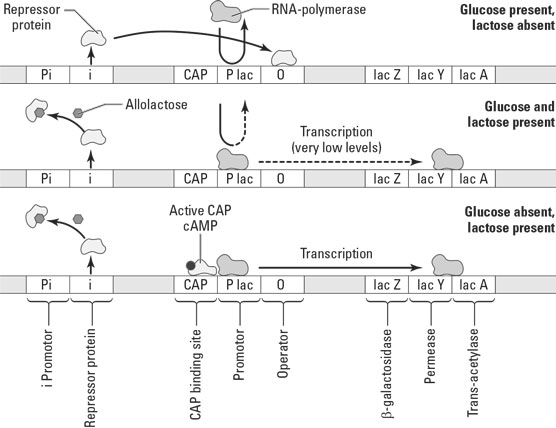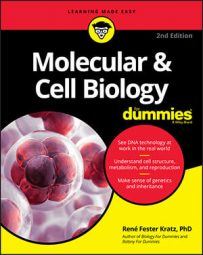The basic steps of gene regulation in bacteria are as follows:
- The cell receives an environmental signal.
- The environmental signal either activates or inactivates a DNA-binding protein.
- DNA-binding proteins either bind to or let go of regulatory sequences in the DNA.
- Transcription is turned on or off by the DNA-binding proteins.
Organizing bacterial genes
Bacteria organize multiple genes under the control of one promoter. The set of genes plus promoter is called an operon.
Typically, the genes in one operon contain the blueprints for proteins that work together in a single process. That way, transcription and translation of the operon make all the proteins needed for the process at the same time.Following are the important elements of a bacterial operon:
- The promoter marks the beginning of the operon. RNA polymerase binds to the operator to begin transcription.
- Structural genes are genes for proteins within the operon. One operon contains several structural genes.
- The operator is a regulatory sequence of DNA located between the promoter and the structural genes. DNA-binding proteins bind to the operator to control transcription of the operon.
Taking E. coli to dinner
Escherichia coli, better known as E. coli, is best known to most people as the bringer of gastrointestinal distress. However, your view of E. coli is probably skewed from the bad rap the bacterium gets in the news media. Basically, a few strains of E. coli run around causing very dangerous diseases and give the whole species a bad name. Many nicer strains of E. coli exist, some of them happily living in your intestines right now. Others are excellent bacterial lab rats, helping scientists learn about cells and how they function. In particular, scientists have discovered a lot about the structure and function of DNA, including gene regulation, from studying E. coli.Like you, E. coli uses enzymes to break down food molecules. E. coli has hundreds of genes for all the different enzymes it makes. Some genes are constitutively expressed. In other words, E. coli makes them all the time. Other genes are regulated — E. coli turns them on when it needs them and turns them off when it doesn’t. For example, the sugar glucose is usually available to E. coli, so E. coli always makes the enzymes it needs to break down glucose. Other food sources are more unpredictable, so E. coli turns on the enzymes to break down these food sources only when they become available.
Looking at lac
Lactose, the sugar found in milk, is occasionally available to E. coli. The genes for the enzymes to break down lactose are located within the lactose operon, or lac operon (see the following figure). The lac operon has three components:- The lac promoter is the binding site for RNA polymerase.
- The lac operator is the binding site for a DNA-binding protein called the lac repressor protein.
- Three structural genes contain the blueprints for the two proteins needed to breakdown lactose plus a blueprint for a protective enzyme.
- The lacZ gene is the blueprint for the enzyme beta-galactosidase (β-galactosidase). Beta-galactosidase catalyzes the splitting of the disaccharide lactose into two monosaccharides, glucose and galactose, and then glycolysis breaks it down.
- The lacY gene is the blueprint for the membrane protein galactosidase permease, which brings lactose into the cell.
- The lacA gene is the blueprint for transacetylase, a protective enzyme that allows certain sugars to be removed from the cell when the sugars are too plentiful.
 Regulation of the lac operon.
Regulation of the lac operon.Feeling repressed
The DNA-binding protein that controls transcription of the lac operon is called the lac repressor protein.The lac repressor is a DNA-binding protein that regulates the lac operon. When the lac repressor is active, it binds to the operator, and transcription is blocked.
The lac repressor has two binding sites that are critical to its function:- A DNA-binding site that binds to the operator sequence of the lac operon
- An allosteric site that binds to an isomer of lactose (called allolactose)
The blueprint for the lac repressor is contained in the I gene, which isn’t part of the lac operon. The I gene is constitutively expressed, so the lac repressor is always available in the cell. When the lac repressor is active, it shuts down the lac operon. Because the active repressor shuts down the operon, regulation of the lac operon by the lac repressor is called negative control.
Game on: Inducing the lac operon
Lactose is the inducer of the lac operon: When lactose is available, it turns the lac operon on so that E. coli can make the enzymes needed to break down lactose.Lactose regulates the lac operon by induction.
Induction, or turning on, of the lac operon allows E. coli to use the lactose as a food source, which makes sense if you think about things from the perspective of E. coli; when lactose is available, E. coli “wants” to eat it.The tricky part about understanding gene regulation is to think about how lactose turns on the lac operon. After all, E. coli can’t really think about what it wants; it’s only a bacterium after all, so how does it “know” when lactose is available? The answer is the lac repressor. When lactose is available, an isomer of lactose (allolactose) binds to the lac repressor and inactivates it. The lac repressor lets go of the operator, and RNA polymerase can bind to the promoter. Transcription of the lac operon can occur and the enzymes to break down lactose are made.
Game over: Repressing the lac operon
The beauty of the regulation of the lac operon is its efficiency: when lactose is available, lactose turns on the lac operon. E. coli makes the enzymes to break down lactose and uses the lactose as a food source. As E. coli uses up the lactose, the allolactose isn’t available to bind to the repressor protein. The repressor protein becomes active again, and binds to the operator. So, when the lactose is gone, the lac operon is turned off again. Again, this process makes sense from the perspective of E. coli — if it doesn’t have any lactose, why make the enzymes to break it down? The tricky part is remembering how this process works: No lactose means no isomer (allolactose) bound to the allosteric site of the lac repressor, which means that the repressor protein binds to the operator and blocks transcription.To help you remember the regulation of the lac operon, think like E. coli. If lactose is available, would you want to make the enzymes to break it down? Of course! So, when lactose is available, the lac operon is on. If lactose isn’t available, do you want to make the enzymes to break it down? Why bother? So, when lactose isn’t available, the lac operon is off.
Advancing to the next level: Catabolite repression of the lac operon
Lactose isn’t the only sugar that has an effect on the regulation of the lac operon; glucose is a player in the game, too. E. coli always makes the enzymes to break down glucose so that the bacterium is always ready to use glucose when glucose is available. In fact, if glucose is available, E. coli won’t even bother making the effort to break down other sugars like lactose. How can a simple bacterium make these kinds of choices? The answer is through the regulatory DNA-binding protein catabolite activator protein (CAP), which responds to the levels of glucose available to the cell.CAP is an activator protein, which means it turns on transcription of genes (as compared to repressor proteins that turn off transcription).
When CAP is active, it turns on transcription of catabolic operons like the lac operon that produce enzymes to break down different food sources (other than glucose).
- When glucose is available, CAP is inactive, so coli doesn’t make new enzymes and doesn’t bother breaking down food molecules other than glucose.
- When glucose runs out, CAP becomes active and turns on catabolic operons, which allows coli to make enzymes for food sources other than glucose.
The details of how CAP responds to the presence of glucose are a bit complicated, but very similar to the workings of the lac repressor protein (see the preceding section “Feeling repressed”). Like the lac repressor, CAP is an allosteric protein with two important binding sites:
- A DNA-binding site that binds to a regulatory sequence of DNA called the CAP-binding site. The CAP-binding site is a sequence of DNA next to the promoters of catabolic operons. When CAP binds to the CAP-binding sites in the DNA, it enhances transcription of the adjacent operons.
- An allosteric site that binds to a signaling molecule named cyclic AMP (cAMP). When cAMP is bound to CAP, CAP is active. When cAMP isn’t bound to CAP, CAP is inactive. In other words, CAP needs cAMP in order to function. (Just like I need a cup of tea in the morning!)
- When glucose levels are high, cAMP levels are low.
- When glucose levels are low, cAMP levels are high.
You can think of cAMP like an alarm signal. When glucose runs out, more cAMP molecules run around the cell saying, “Oh no! We’re running out of food!” The cAMP molecules bind to CAP and activate it. Together, cAMP and CAP bind to the CAP binding site near the promoters of catabolic operons and turn them on, so E. coli makes enzymes to break down other food molecules besides glucose.
The levels of cAMP change as glucose levels change because glucose acts as a regulator of the enzyme adenylate cyclase, which makes cAMP out of ATP. When glucose is available, it binds to an allosteric site on adenylate cyclase and inactivates the enzyme so that no cAMP is made. When glucose isn’t available, it can’t bind to adenylate cyclase. Adenylate cyclase is active and produces cAMP from ATP.
To fully understand the regulation of the lac operon, you have to put the two regulatory systems together: negative control by the lac repressor combined with positive control by CAP. Remember that these two systems are independent of each other:- Lactose is the environmental signal that interacts with the lac
- Glucose is the environmental signal that interacts with CAP.
- If glucose is present and lactose is absent, the volume is low, and the switch is off. No transcription of the lac operon occurs.
- If glucose and lactose are present, the volume is low, and the switch is on. Very low levels of transcription of the lac operon occur.
- If glucose is absent and lactose is present, the volume is high, and the switch is on. Very high levels of transcription of the lac operon occur.
The hardest part of understanding gene regulation is getting the details straight on which molecules bind where and understanding their effects. The best strategy I’ve found for learning these details is to practice drawing the regulation of the lac operon in different conditions (different sugars available). In other words, practice re-creating the figure for yourself on a blank piece of paper. Draw the lac operon and then say to yourself, “If lactose is present, what is the effect?” Draw all the regulatory molecules onto the lac operon, describing what is happening out loud. Repeat your drawings for all the conditions shown. The combination of drawing, seeing, and hearing will help reinforce the information. Practice until you can re-create the figure with ease, narrating as you go.

